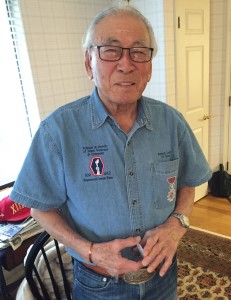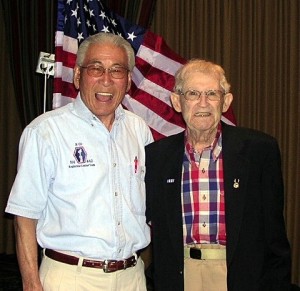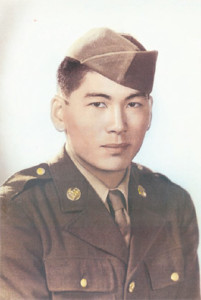Rescuing the Lost Battalion
LISTEN to Lawson Sakai on Hometown Heroes (Part I) — or — LISTEN to Part II of Lawson Sakai’s interview
92-year-old Lawson Sakai of Morgan Hill, CA appears on episode #405 of Hometown Heroes, debuting February 6, 2016. A native of Los Angeles, Sakai graduated from Montebello High School in 1941, working on his family’s farm throughout his younger years.

92-year-old Lawson Sakai on the day of our interview. CLICK HERE for a short video of Mr. Sakai explaining how he was wounded on October 28, 1944.
On December 7, 1941, his world changed. You’ll hear Mr. Sakai remember how he heard the news about Imperial Japan’s attack on Pearl Harbor, and the shock of what happened later that day. The FBI showed up at the Sakai’s Los Angeles area farm and carried away Lawson’s uncle, the leader of Los Angeles’ largest produce market. Lawson had just finished football season at Compton Junior College, where one of his teammates was Basketball Hall of Famer Tex Winter, and was gearing up for baseball in the spring. That didn’t stop him from heading to a Navy recruiting station on December 8, 1941, and trying to enlist.
“I’m sorry but you’re not classified 1-A,” the officer told him. “You’re now classified 4-C, enemy alien.”
President Franklin D. Roosevelt issued Executive Order 9066 on February 19, 1942, paving the way for 120,000 Japanese-Americans on the West Coast to be “relocated” to internment camps. With help from the Seventh Day Adventist church, Lawson Sakai’s family had moved north and inland to the San Joaquin Valley to avoid incarceration. When it became clear that California’s entire Japanese American population would be evacuated, the Sakais moved to Colorado, again through church connections.
His determination to serve his country was demonstrated again at what is now Colorado Mesa University in Grand Junction, where he enrolled in the V-12 Navy College Training Program. A month later, his Japanese ancestry was revealed, and he was kicked out of the program. His opportunity to serve finally arrived with the formation of the 442nd Regimental Combat Team in 1943.
“If you’re an American, you should fight for your country,” Sakai says about his motivation. “And none of us, when we did so, thought we’d come home alive.”
The 442nd would see 650 soldiers killed during the war, another 67 missing in action. Lawson Sakai was one of more than 3,700 from the unit to be wounded during World War II. Assigned a Browning Automatic Rifle initially, Sakai later became a squad leader, a move necessitated by casualties that reduced the 442nd to less than 50% strength. In October 1944, the 1st Battalion, 141st Regiment, 36th Infantry Division was surrounded by Nazi forces in the Vosges Mountains. After two other units failed to break through German lines, the “Go For Broke” fighters of the 442nd were called upon to rescue this “Lost Battalion.”

Lawson Sakai with Marty Higgins, one of the 211 “Lost Battalion” soldiers rescued by the 442nd RCT. (photo from hirasaki.net)
“During that two-week battle, we had over 800 casualties,” you’ll hear Sakai remember. “Over two hundred boys were killed. The weather was awful.” Battling, rain, snow, fog, and a determined enemy, the 442nd broke through on October 30, 1944. The lives of 211 men in the “Lost Battalion” were saved, including many who were badly wounded. One of those men, Marty Higgins, later told Sakai they had no food, no access to water, no medical supplies, and were running out of ammunition. Those 211 men “would not have made the day if the 442nd hadn’t come through,” Higgins said. Sakai didn’t get to witness the culmination of those two weeks of intense combat. He was wounded badly on October 28, 1944.
“The shrapnel that got me, if it came straight through it would’ve blown a hole through me,” you’ll hear Sakai explain on Hometown Heroes. “But it came in at an angle, so it wrapped around in my ribs.”
He expected to die on the battlefield, even telling the medic to let him die. Thankfully, that was a request that wasn’t granted. The medic provided enough morphine to knock Lawson out, and he didn’t regain consciousness until he was on a train to a hospital in Dijon, France. After three months spent recovering from his injuries and the operations that followed, he returned to combat with the 442nd. Mr. Sakai’s story continues on episode #406 of Hometown Heroes, with additional details including the unique way in which he met Al Tortolano, another one of the “Lost Battalion” soldiers he helped rescue. Mr. Tortolano shared his story on Hometown Heroes in 2011, and you can listen to that podcast HERE.
On Saturday, February 13, you can catch Mr. Sakai and Mr. Tortolano sharing their stories in person in Morgan Hill, CA. Also participating in the panel discussion will be Franz Steidl, author of the book Lost Battalions. The event starts at 11:30 a.m. on February 13, and will be held at the Morgan Hill Buddhist Community Center at 16450 Murphy Ave.
—Paul Loeffler




Pingback: Rescuing the Lost Battalion – Kyle The RV Guy
Pingback: Hometown Heroes Radio » Day of Remembrance: Tears of Honor
Pingback: Hometown Heroes Radio » College Footballers Called to War
Pingback: Hometown Heroes Radio » New Documentary Spotlights Nisei Veterans